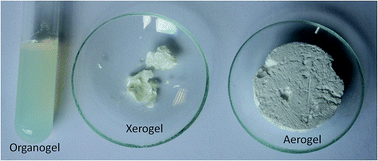Monolithic organic aerogels derived from single amino-acid based supramolecular gels: physical and thermal properties
Abstract
Highly porous materials have numerous applications in research fields such as filtration and collection devices, catalysis and electric devices or in acoustic and thermal insulation. In the latter, inorganic and/or macromolecular chemical gels have been extensively studied. Herein, a new type of monolithic aerogel, made of self-assembled small organic molecules, is described. The low-molecular weight aerogels (LMWA) are prepared from amino acid-based (phenylalanine or leucine) supramolecular gels using a CO2 supercritical drying process. The organogels and aerogels exhibit very interesting properties. Indeed, the gelator molecules are able to immobilize aromatic solvents such as toluene or tetralin at low concentrations. The melting enthalpies (ΔH) were calculated for both gelator molecules and for both solvents. In the case of the aerogels, an important hydrophobic character, a very low density and remarkable thermal properties were observed. For the former, the measured contact angles were found to be between 110 and 114°. As for the second, the organic aerogels belong to the family of the lightest porous materials in the world with densities as low as 4.3 kg m−3. Finally, the thermal measurements show that these LMWAs present a low thermal conductivity under atmospheric pressure (λ = 26.5 mW m−1 K−1) and very low thermal conductivity under vacuum (λ = 4 mW m−1 K−1 at 10−2 mbar). Moreover, measurement of the radiative conductivity demonstrated that the LMWAs are a good scattering materials with 80 to 90% of infrared radiation stopped. Such characteristics make these materials viable candidates for use in thermal insulation.


 Please wait while we load your content...
Please wait while we load your content...